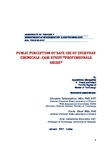| dc.contributor.advisor | Τσιτσιμπίκου, Χριστίνα | el |
| dc.contributor.advisor | Φούφα, Ελένη | el |
| dc.contributor.advisor | Κουρέτας, Δημήτριος Δ. | el |
| dc.creator | Απατσίδου, Μαργαρίτα | el |
| dc.date.accessioned | 2019-07-03T11:42:18Z | |
| dc.date.available | 2019-07-03T11:42:18Z | |
| dc.date.issued | 2017 | |
| dc.identifier.other | 15935 | |
| dc.identifier.uri | http://hdl.handle.net/11615/50202 | |
| dc.identifier.uri | http://dx.doi.org/10.26253/heal.uth.5413 | |
| dc.language.iso | en | en |
| dc.rights | Attribution-NonCommercial-NoDerivatives 4.0 International | en |
| dc.rights.uri | http://creativecommons.org/licenses/by-nc-nd/4.0/ | en |
| dc.subject.other | Επικίνδυνες ουσίες -- Μέτρα ασφαλείας | el |
| dc.subject.other | Επικίνδυνες ουσίες -- Εικονογράμματα κινδύνου | el |
| dc.subject.other | Επικίνδυνες ουσίες -- Δίκαιο και νομοθεσία | el |
| dc.subject.other | Επικίνδυνες ουσίες -- Ταξινόμηση | el |
| dc.title | Public perception of safe use of everyday chemicals: case study "Professionals users" | en |
| dc.type | masterThesis | en |
| heal.recordProvider | Πανεπιστήμιο Θεσσαλίας - Βιβλιοθήκη και Κέντρο Πληροφόρησης | el |
| heal.academicPublisher | Πανεπιστήμιο Θεσσαλίας. Σχολή Επιστημών Υγείας. Τμήμα Βιοχημείας και Βιοτεχνολογίας. | el |
| heal.academicPublisherID | uth | en |
| heal.fullTextAvailability | true | en |
| dc.rights.accessRights | free | en |

